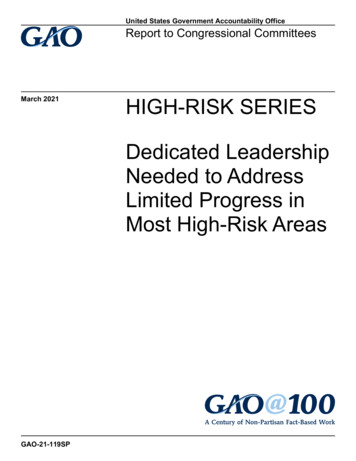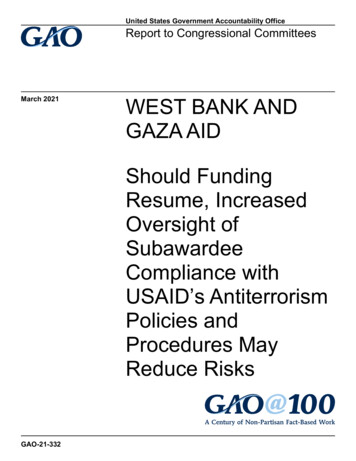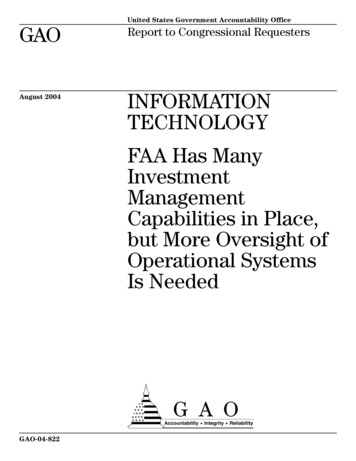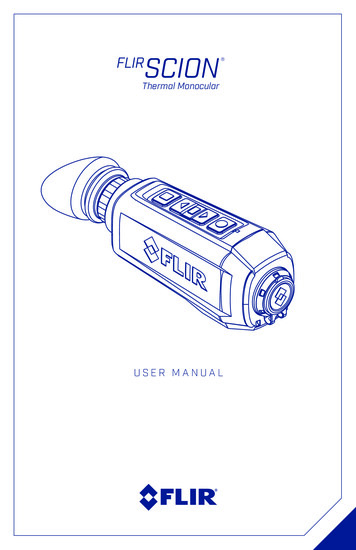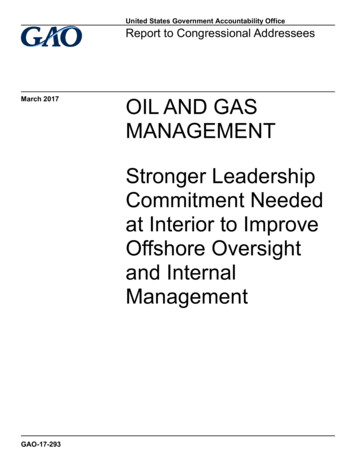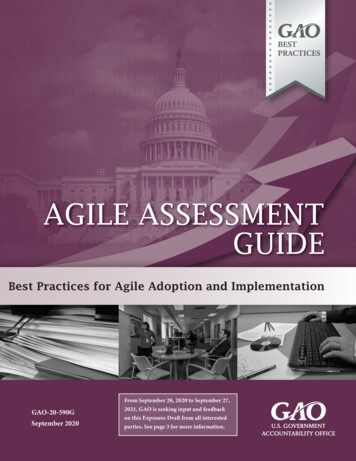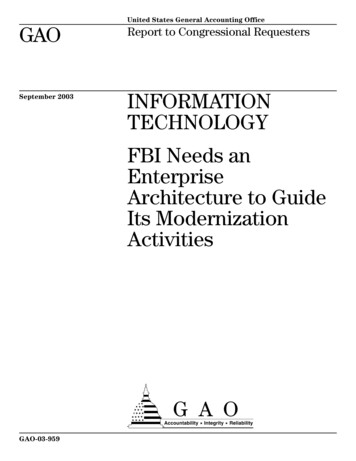
Transcription
United States General Accounting OfficeGAOReport to Congressional RequestersSeptember 2003INFORMATIONTECHNOLOGYFBI Needs anEnterpriseArchitecture to GuideIts ModernizationActivitiesGAO-03-959a
September 2003INFORMATION TECHNOLOGYHighlights of GAO-03-959, a report tocongressional requestersThe Federal Bureau ofInvestigation (FBI) is in theprocess of modernizing itsinformation technology (IT)systems. Replacing much of its1980s-based technology withmodern system applications and arobust technical infrastructure, thismodernization is intended toenable the FBI to take anintegrated approach—coordinatedagencywide—to performing itscritical missions, such as federalcrime investigation and terrorismprevention. GAO was requested toconduct a series of reviews of theFBI’s modernization management.The objective of this first reviewwas to determine whether the FBIhas an enterprise architecture toguide and constrain modernizationinvestments.GAO recommends that the FBIDirector designate thedevelopment of a completeenterprise architecture as abureauwide priority and take thenecessary steps to manage thisdevelopment accordingly, includingensuring key enterprisearchitecture management practicesspecified in GAO’s maturityframework are implemented.We provided a draft of this reportto the FBI on August 22, 2003, forits review and comment, but nocomments were received in timefor issuance of this final report.FBI Needs an Enterprise Architecture toGuide Its Modernization ActivitiesAbout 2 years into its ongoing systems modernization efforts, the FBI doesnot yet have an enterprise architecture. An enterprise architecture is anorganizational blueprint that defines—in logical or business terms and intechnology terms—how an organization operates today, intends to operatein the future, and intends to invest in technology to transition to this futurestate. GAO’s research has shown that attempting to modernize an ITenvironment without a well-defined and enforceable enterprise architecturerisks, among other things, building systems that do not effectively andefficiently support mission operations and performance.The FBI acknowledges the need for an enterprise architecture and hascommitted to developing one by the fall of 2003. However, it currently lacksthe means for effectively reaching this end. For example, while the bureaudid recently designate a chief architect and select an architecture frameworkto use, it does not yet have an agency architecture policy, an architectureprogram management plan, or an architecture development methodology, allof which are necessary components of effective architecture management.Given the state of the FBI’s enterprise architecture management efforts, thebureau is at Stage 1 of GAO’s enterprise architecture management maturityframework (see table). Organizations at Stage 1 are characterized byarchitecture efforts that are ad hoc and unstructured, lack institutionalleadership and direction, and do not provide the management foundationnecessary for successful architecture development and use as a tool forinformed IT investment decision making. A key for an organization toadvance beyond this stage is to treat architecture development,maintenance, and implementation as an institutional management priority,which the FBI has yet to do. To do less will expose the bureau’s ongoing andplanned modernization efforts to unnecessary risk.GAO’s Framework for Enterprise Architecture (EA) Management MaturityMaturity stageStage 1: Creating EAawarenessStage 2: Building theEA managementfoundationStage 3: Developingthe EAStage 4: Completingthe EAwww.gao.gov/cgi-bin/getrpt?GAO-03-959.To view the full product, including the scopeand methodology, click on the link above.For more information, contact Randolph C.Hite at (202) 512-3439 or hiter@gao.gov.Stage 5: Leveragingthe EA to managechangeSource: GAO.DescriptionOrganization does not have plans to develop and use an architecture, orits plans do not demonstrate an awareness of an architecture’s value.Organization recognizes EA as a corporate asset by vesting responsibilityin an executive body with enterprisewide representation. It also developsplans for creating EA products and for measuring program progress andproduct quality and commits resources necessary to develop an EA.Organization is developing architecture products according to aframework, methodology, tool, and established management plans. EAproducts are not yet complete, but scope is defined and progress tracked.Organization has completed its EA products, which have been approvedby management and verified by an independent agent. Further EAevolution is governed by a written EA maintenance policy.EA is being used by organization to manage and control IT investments,ensuring interoperability and avoiding overlap. Organization requires thatinvestments comply with EA via written institutional policy. It also tracksand measures EA benefits or return on investment, adjusting EAmanagement processes and products as needed.
ContentsLetter112Results in BriefBackgroundFBI Does Not Have an EA or the Management Foundation Needed toEffectively Develop, Maintain, and Implement OneConclusionsRecommendationsAgency Comments10171819Scope and Methodology21Assessment of FBI’s Enterprise Architecture (EA) Effortsagainst GAO’s EA Management Maturity Framework22GAO Contact and Staff AcknowledgmentsGAO ContactAcknowledgments252525AppendixesAppendix I:Appendix II:Appendix III:TablesTable 1: FBI Organizational Components and MissionResponsibilitiesTable 2: Summary of GAO EA Management Framework MaturityStages and Core Elements415AbbreviationsCIODNAEAFBIGAOITchief information officerdeoxyribonucleic acidenterprise architectureFederal Bureau of InvestigationGeneral Accounting Officeinformation technologyThis is a work of the U.S. government and is not subject to copyright protection in theUnited States. It may be reproduced and distributed in its entirety without furtherpermission from GAO. However, because this work may contain copyrighted images orother material, permission from the copyright holder may be necessary if you wish toreproduce this material separately.Page iGAO-03-959 FBI Enterprise Architecture
AUnited States General Accounting OfficeWashington, D.C. 20548September 25, 2003LeterThe Honorable Porter J. GossChairman, Permanent Select Committee on IntelligenceHouse of RepresentativesThe Honorable Nancy PelosiHouse of RepresentativesThe Honorable Bob GrahamUnited States SenateThe Honorable Richard C. ShelbyUnited States SenateThe Federal Bureau of Investigation (FBI) is in the process of modernizingits information technology (IT) systems. Its goal is to replace much of its1980s-based IT environment to better support its plans for an agencywideapproach to performing critical mission operations, including terrorismprevention and federal crime investigation. As you requested, we areconducting a series of reviews of the FBI’s management of itsmodernization activities. The objective of this first review was to determinewhether the FBI has a modernization blueprint, commonly called anenterprise architecture,1 to guide and constrain its modernization efforts.Our research has shown that attempting to modernize an IT environmentwithout a well-defined and enforceable enterprise architecture risks,among other things, building systems that do not effectively and efficientlysupport mission operations and performance. Details of our scope andmethodology are in appendix I.Results in BriefThe FBI does not have an enterprise architecture, although it began effortsto develop one about 32 months ago and has invested hundreds of millionsof dollars in new systems over the last 2 years. Moreover, it does not yethave the means in place to effectively develop, maintain, and implement anenterprise architecture. That is, it does not have most of the architecture1An enterprise architecture is a set of descriptive models (e.g., diagrams and tables) thatdefine, in business terms and in technology terms, how an organization operates today, howit intends to operate in the future, and how it intends to invest in technology to transitionfrom today’s operational environment to tomorrow’s.Page 1GAO-03-959 FBI Enterprise Architecture
management structures and processes advocated by federal guidance andbest practices. For instance, the bureau does not have such architecturemanagement controls as an agency architecture policy, an architectureprogram management plan, an architecture development methodology, andan automated architecture tool (a repository for architecturedocumentation).Given the state of the FBI’s enterprise architecture management efforts, thebureau has yet to advance beyond Stage 1, the beginning stage, of our bestpractices-based, five-stage enterprise architecture management maturityframework.2 Organizations at Stage 1 are characterized by architectureefforts that are ad hoc and unstructured, lack institutional leadership anddirection, and do not provide the management foundation necessary forsuccessful architecture development and use for informed IT investmentdecision making. Key for an organization to advance beyond this stage is tofirst treat architecture development, maintenance, and implementation asan institutional management priority, which the FBI has yet to do, and toadopt architecture management best practices. To do less will continue toexpose the bureau’s ongoing and planned modernization efforts tounnecessary risk. Accordingly, we are making recommendations to theFBI’s Director to assist in improving the bureau’s enterprise architectureefforts. We provided a draft of this report to the FBI on August 22, 2003, forits review and comment, but no comments were received in time forissuance of this final report.BackgroundThe FBI was founded in 1908 to serve as the primary investigative bureauof the Department of Justice. Its mission includes upholding the law byinvestigating serious federal crimes; protecting the nation from foreignintelligence and terrorist threats; providing leadership and assistance tofederal, state, local, and international law enforcement agencies; and beingresponsive to the public in the performance of these duties. Approximately11,000 special agents and 16,000 professional support personnel are locatedat the bureau’s Washington, D.C., headquarters and at more than 400 officesthroughout the United States and 44 offices in foreign countries.2U.S. General Accounting Office, Information Technology: A Framework for Assessing andImproving Enterprise Architecture Management (Version 1.1), GAO-03-584G (Washington,D.C.: April 2003).Page 2GAO-03-959 FBI Enterprise Architecture
Mission responsibilities at the bureau are divided among five majororganizational components: Criminal Investigations, Law EnforcementServices, Counterterrorism and Counterintelligence, Intelligence, andAdministration. Criminal Investigations, for example, investigates seriousfederal crimes, including those associated with organized crime, violentoffenses, white-collar crime, government and business corruption, and civilrights infractions. It also probes federal statutory violations involvingexploitation of the Internet and computer systems for criminal, foreignintelligence, and terrorism purposes. (The major components and theirassociated mission responsibilities are shown in table 1.) Each componentis headed by an Executive Assistant Director who reports to the DeputyDirector, who in turn reports to the Director.To execute its mission responsibilities, the FBI relies on the use of IT. Forexample, it develops and maintains computerized IT systems such as theCombined DNA3 Index System to support forensic examinations, theDigital Collection System to electronically collect information on knownand suspected terrorists and criminals, and the National Crime InformationCenter and the Integrated Automated Fingerprint Identification System tohelp state and local law enforcement agencies identify criminals.According to FBI estimates, the bureau manages hundreds of systems,networks, databases, applications, and associated tools such as these at anaverage annual cost of about 800 million.3Deoxyribonucleic acid.Page 3GAO-03-959 FBI Enterprise Architecture
Table 1: FBI Organizational Components and Mission ResponsibilitiesComponentMission responsibilitiesCriminal InvestigationsInvestigates serious federal crimes, including those associated with organized crime, violentoffenses, white-collar crime, government and business corruption, and civil rights infractionsProbes federal statutory violations involving exploitation of the Internet and computersystems for criminal, foreign intelligence, and terrorism purposesLaw Enforcement ServicesResponds to and manages crisis incidents such as terrorist activities, child abductions, andother repetitive violent crimesProvides information services on fingerprint identification, stolen automobiles, criminals,crime statistics, and other information to state, local, and international law enforcementPerforms forensic examinations in support of criminal investigations and prosecutions,including crime scene searches, DNA testing, photographic surveillance, expert courttestimony, and other technical servicesTrains FBI agents and support personnel as well as state, local, international, and otherfederal law enforcement in crime investigation, law enforcement, and forensic investigativetechniquesCounterterrorism and Counterintelligence Identifies and neutralizes ongoing national security threats, including conducting foreigncounterintelligence investigations, coordinates investigations within the U.S. intelligencecommunity, and investigates violations of federal espionage statutesAssesses threats or attacks against critical U.S. infrastructure, issues warnings, andinvestigates and develops national responses to threats and attacksIntelligenceCollects and analyzes information on evolving threats to the United States and ensures itsdissemination within the FBI, to state and local law enforcement, and to the U.S. intelligencecommunityAdministrationDevelops and administers the bureau’s personnel programs and services, includingrecruiting, conducting background investigations, and other administrative activitiesAdministers the bureau’s budget and fiscal matters, including financial planning, payrollservices, property management, and procurement activitiesManages and plans for the bureau’s use of information resourcesInvestigates allegations of criminal conduct and serious misconduct by FBI employeesManages policies, processes, and systems used by the bureau to control its extensiveinvestigative and other recordsEnsures a safe and secure FBI work environment, including preventing the compromise ofnational security and FBI informationSource: GAO based on FBI data.Page 4GAO-03-959 FBI Enterprise Architecture
FBI’s Existing ITEnvironment Has LongSuffered from KnownDeficienciesSeveral prior reviews of the FBI’s existing IT environment have revealedthat it is antiquated and not integrated. Specifically, the Department ofJustice Inspector General reported4 that as of September 2000, the FBI hadover 13,000 desktop computers that were 4 to 8 years old and could not runbasic software packages. Moreover, it reported that some communicationsnetworks were 12 years old and obsolete, and that many end-userapplications existed that were neither Web-enabled nor user-friendly. Inaddition, a December 2001 review initiated by the Department of Justice5found that FBI’s IT environment was disparate. In particular, it identified234 nonintegrated (“stove-piped”) applications, residing on 187 differentservers, each of which had its own unique databases and did not shareinformation with other applications or with other government agencies.Moreover, in June 2002, we reported6 that IT has been a long-standingproblem for the bureau, involving outdated hardware, outdated software,and the lack of a fully functional E-mail system. We also reported that thesedeficiencies served to significantly hamper the FBI’s ability to shareimportant and time-sensitive information internally and externally withother intelligence and law enforcement agencies.FBI Has Initiated a Large,Complex SystemsModernizationFollowing the terrorist attacks of September 11, 2001, the FBI refocused itsefforts to investigate the events and to detect and prevent possible futureattacks. To do this, the bureau changed its priorities and acceleratedmodernization of its IT systems. Collectively, the FBI’s many modernizationefforts involve 51 initiatives that the FBI reported will cost about 1.5billion between fiscal years 2002 and 2004. For example, the Trilogyproject, which is to introduce new systems infrastructure and applications,includes establishing an enterprisewide network to enablecommunications between hundreds of FBI locations domestically andabroad, upgrading 20,000 desktop computers, and providing 2,400 printersand 1,200 scanners. In addition, a new investigative data warehousinginitiative called Secure Counterterrorism Operational Prototype4U.S. Department of Justice Office of the Inspector General, Federal Bureau ofInvestigation’s Management of Information Technology Investments, Report 03-09(Washington, D.C.: December 2002).5Arthur Andersen, LLP, Management Study of the Federal Bureau of Investigation (Dec. 14,2001).6U.S. General Accounting Office, FBI Reorganization: Initial Steps Encouraging butBroad Transformation Needed, GAO-02-865T (Washington, D.C.: June 21, 2002).Page 5GAO-03-959 FBI Enterprise Architecture
Environment is to (1) aggregate voluminous counterterrorism filesobtained from both internal and external sources and (2) acquire analyticalcapabilities to improve the FBI’s ability to analyze these files. Anotherinitiative, called the FBI Administrative Support System, is to integrate thebureau’s financial management and administrative systems with theDepartment of Justice’s new financial management system.Beyond the scope and size of the FBI’s modernization effort is the need toensure that the modernized systems effectively support informationsharing within the bureau and among its law enforcement and intelligencecommunity partners. This means that the modernized FBI systems will, inmany cases, have to interface with existing (legacy) systems to obtain datato accomplish their functions, which bureau officials said will bechallenging, given the nonstandard and disparate nature of the existing ITenvironment. Moreover, bureau staff will have to be trained on the newsystems and business processes modified to accommodate their use.An Enterprise ArchitectureIs Essential to EffectivelyManaging SystemsModernizationThe development, maintenance, and implementation of enterprisearchitectures (EA) are recognized hallmarks of successful public andprivate organizations and as such are an IT management best practice. EAsare essential to effectively managing large and complex systemmodernization programs, such as the FBI’s. Our experience with federalagencies has shown that attempting a major modernization effort without awell-defined and enforceable EA results in systems that are duplicative, arenot well integrated, are unnecessarily costly to maintain and interface, anddo not effectively optimize mission performance.7The Congress and the Office of Management and Budget have recognizedthe importance of agency EAs. The Clinger-Cohen Act, for example,requires that agency Chief Information Officers (CIO) develop, maintain,and facilitate the implementation of architectures as a means of integrating7See, for example, U.S. General Accounting Office, DOD Business Systems Modernization:Improvements to Enterprise Architecture Development and Implementation EffortsNeeded, GAO-03-458 (Washington, D.C.: February 2003); Information Technology: DLAShould Strengthen Business Systems Modernization Architecture and InvestmentActivities, GAO-01-631 (Washington, D.C.: June 2001); and Information Technology: INSNeeds to Better Manage the Development of Its Enterprise Architecture, GAO/AIMD-00-212(Washington, D.C.: August 2000).Page 6GAO-03-959 FBI Enterprise Architecture
business processes and agency goals with IT.8 In response to the act, theOffice of Management and Budget, in collaboration with us and others, hasissued guidance on the development and implementation of thesearchitectures.9 It has also issued guidance that requires agency investmentsin information systems to be consistent with agency architectures.10An EA is a systematically derived snapshot—in useful models, diagrams,and narrative—of a given entity’s operations (business and systems),including how its operations are performed, what information andtechnology are used to perform the operations, where the operations areperformed, who performs them, and when and why they are performed.The architecture describes the entity in both logical terms (e.g.,interrelated functions, information needs and flows, work locations,systems, and applications) and technical terms (e.g., hardware, software,data, communications, and security). EAs provide these perspectives forboth the entity’s current (or “as-is”) environment and for its target (or “tobe”) environment; they also provide a high-level capital investmentroadmap for moving from one environment to the other.Among others, the Office of Management and Budget, the National Instituteof Standards and Technology, and the federal CIO Council have issuedframeworks that define the scope and content of architectures.11 Forexample, the federal CIO Council issued a framework, known as theFederal Enterprise Architecture Framework, in 1999. While the variousframeworks differ in their nomenclatures and modeling approaches, theyconsistently provide for defining an enterprise architecture’s operations inboth logical terms and technical terms and providing these perspectivesboth for the “as-is” and “to-be” environments, as well as the investmentroadmap. Managed properly, an enterprise architecture can clarify and helpoptimize the interdependencies and relationships among a given entity’s840 U.S.C. 111315(b)(2).9Office of Management and Budget, Information Technology Architectures, MemorandumM-97-16 (June 18, 1997), rescinded with the update of Office of Management and BudgetCircular A-130 (Nov. 30, 2000).10Office of Management and Budget, Management of Federal Information Resources,Circular A-130 (Nov. 30, 2000).11Office of Management and Budget Circular A-130; National Institute of Standards andTechnology, Information Management Directions: The Integration Challenge, SpecialPublication 500-167 (September 1989); and federal CIO Council, Federal EnterpriseArchitecture Framework, Version 1.1 (September 1999).Page 7GAO-03-959 FBI Enterprise Architecture
business operations and the underlying systems and technicalinfrastructure that support these operations.The FBI’s Lack of an EA HasBeen Previously ReportedOver the past few years, several reviews related to the FBI’s managementof its IT have focused on enterprise architecture efforts and needs. Forexample, in July 2001, the Department of Justice hired a consulting firm toreview the FBI’s IT management. Among other things, the consultantrecommended that the bureau develop a comprehensive EA to help reducethe proliferation of disparate, noncommunicating applications.12The next year, in February 2002, we reported as part of a governmentwidesurvey of the state of EA maturity that the FBI was one of a number offederal agencies that were not effectively managing their architectureefforts, and we made recommendations to the Office of Management andBudget for advancing the state of architecture maturity across the federalgovernment.13 In this report, we noted that while the FBI was attempting tolay the management foundation for developing an architecture, the bureauhad not yet established certain basic management structures and controls,such as establishing a steering committee or group that had responsibilityfor directing and overseeing the development of the architecture.Later, our June 2002 testimony14 recommended that the FBI significantlyupgrade its IT management capabilities, including developing anarchitecture, in order to successfully change its mission and effectivelytransform itself. Subsequently, in December 2002, the Department ofJustice Inspector General reported15 that the FBI needed to complete anarchitecture to complement its IT investment management processes.12Arthur Andersen, LLP, Management Study of the Federal Bureau of Investigation(Dec. 14, 2001).13U.S. General Accounting Office, Information Technology: Enterprise Architecture UseAcross the Federal Government Can Be Improved, GAO-02-6 (Washington, D.C.: Feb. 19,2002).14GAO-02-865T.15U.S. Department of Justice Office of the Inspector General, Federal Bureau ofInvestigation’s Management of Information Technology Investments, Report 03-09(Washington, D.C.: December 2002).Page 8GAO-03-959 FBI Enterprise Architecture
GAO’s EA ManagementMaturity FrameworkProvides a Tool forMeasuring and ImprovingEA ManagementEffectivenessAccording to guidance published by the federal CIO Council,16 effectivearchitecture management consists of a number of key practices andconditions (e.g., establishing a governance structure, developing policy,defining management plans, and developing and issuing an architecture). InApril 2003, we published a maturity framework that arranges these keypractices and conditions (i.e., core elements) of the council’s guide into fivehierarchical stages, with Stage 1 representing the least mature and Stage 5being the most mature.17 The framework provides an explicit benchmarkfor gauging the effectiveness of EA management and provides a roadmapfor making improvements. Each of the five stages is described below.1. Creating EA awareness. The organization does not have plans todevelop and use an architecture, or it has plans that do not demonstratean awareness of the value of having and using an architecture. WhileStage 1 agencies may have initiated some EA activity, these agencies’efforts are ad hoc and unstructured, lack institutional leadership anddirection, and do not provide the management foundation necessary forsuccessful EA development.2. Building the EA management foundation. The organizationrecognizes that the EA is a corporate asset by vesting accountability forit in an executive body that represents the entire enterprise. At thisstage, an organization assigns EA management roles andresponsibilities and establishes plans for developing EA products andfor measuring program progress and product quality; it also commitsthe resources necessary for developing an architecture—people,processes, and tools.3. Developing the EA. The organization focuses on developingarchitecture products according to the selected framework,methodology, tool, and established management plans. Roles andresponsibilities assigned in the previous stage are in place, andresources are being applied to develop actual EA products. The scopeof the architecture has been defined to encompass the entireenterprise, whether organization-based or function-based.16Federal CIO Council, A Practical Guide to Federal Enterprise Architecture, Version 1.0(February 2001).17GAO-03-584G.Page 9GAO-03-959 FBI Enterprise Architecture
4. Completing the EA. The organization has completed its EA products,meaning that the products have been approved by the EA steeringcommittee or an investment review board, and by the CIO. Further, anindependent agent has assessed the quality (i.e., completeness andaccuracy) of the EA products. Additionally, evolution of the approvedproducts is governed by a written EA maintenance policy approved bythe head of the organization.5. Leveraging the EA to manage change. The organization has securedsenior leadership approval of the EA products and has a writteninstitutional policy stating that IT investments must comply with thearchitecture, unless granted an explicit compliance waiver. Further,decision makers are using the architecture to identify and addressongoing and proposed IT investments that are conflicting, overlapping,not strategically linked, or redundant. Also, the organization tracks andmeasures EA benefits or return on investment, and adjustments arecontinuously made to both the EA management process and the EAproducts.FBI Does Not Have anEA or the ManagementFoundation Needed toEffectively Develop,Maintain, andImplement OneThe FBI has yet to develop an EA, and it does not have the requisite meansin place to effectively develop, maintain, and implement one. The state ofthe bureau’s architecture efforts is attributable to the level of managementpriority and commitment that the bureau has assigned to this effort. Unlessthis changes, it is unlikely the FBI will produce a complete and usefularchitecture, and without the architecture, the bureau will be severelychallenged in its ability to implement a set of modernized systems thatoptimally support critical mission needs.FBI Does Not Have anArchitectureAn EA is an essential tool for effectively and efficiently engineeringbusiness operations (e.g., processes, work locations, and informationneeds and flows) and defining, implementing, and evolving IT systems in away that best supports these operations. As mentioned earlier, an EAprovides systematically derived and captured structural descriptions—inuseful models, diagrams, tables, and narrative—of how a given entityoperates today and how it plans to operate in the future, and it includes aroadmap for transitioning from today to tomorrow. The nature and contentof these descriptions vary among organizations depending on the EAframework selected.Page 10GAO-03-959 FBI Enterprise Architecture
The FBI has selected the federal CIO Council’s Federal EnterpriseArchitecture Framework as the basis for defining its EA. At the highestlevel of component content description, the Federal Enterpris
Page 2 GAO-03-959 FBI Enterprise Architecture management structures and processes advocated by federal guidance and best practices. For instance, the bureau does not have such architecture management controls as an agency architecture policy, an architecture program management plan, an architec ture development methodology, and
